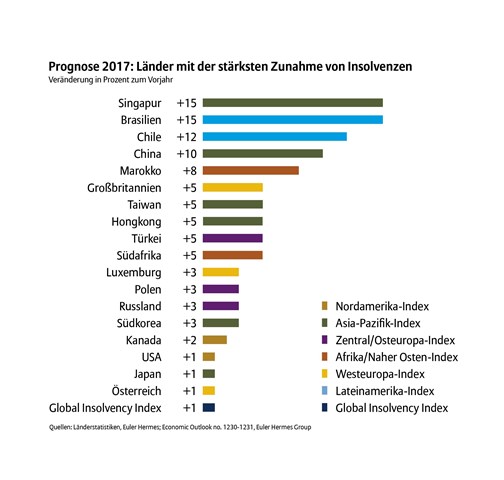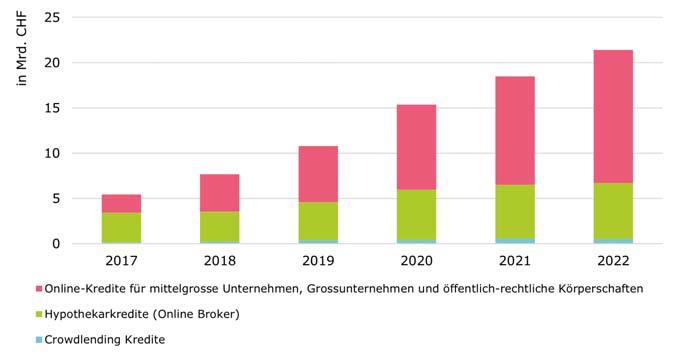Corporate insolvency forecast: number of insolvencies on the rise worldwide
Insolvency cases are expected to rise by 1% worldwide in 2017. According to credit insurer Euler Hermes, this marks a trend reversal. In Switzerland, corporate bankruptcies rose in 2016, but are expected to stagnate in 2017.

Not only Switzerland is likely to see a trend reversal with stagnating insolvencies in 2017, but also the global corporate scene: In its current study "Insolvencies: The tip of the iceberg", credit insurer Euler Hermes concludes that the number of global insolvencies is likely to increase by 1% in 2017. The main drivers of this increase are negative forecasts for Latin America (+12% insolvencies in 2017), Africa (+9%), Asia-Pacific (+6%) and North America (+1%), it says. Most worrying is the trend toward significantly rising losses from bankruptcies, according to Ludovic Subran, chief economist at Euler Hermes Group. "In the first three quarters of 2016, we recorded 45% more large insolvencies than in the same period last year. This is creating a negative snowball effect that will continue in 2017." Although the global economy is growing by about 2.8%, the growth is not strong enough to prevent an increase in insolvencies. Global GDP growth will also remain below the 3% mark in the long term.
Switzerland: After rising number of bankruptcies in 2016, stagnation in 2017
With the floating of the Swiss franc exchange rate against the euro in January 2015 and the resulting appreciation shock for the export industry, the phase of declining corporate bankruptcies ended in Switzerland. The trend of rising corporate bankruptcies continued in 2016: Following an increase of 7% in 2015, the number of bankruptcies rose by a further 5% by the end of November 2016. French-speaking Switzerland, Ticino and eastern Switzerland were particularly affected. In central Switzerland, however, the numbers are declining. "For 2017, Euler Hermes expects the number of bankruptcies in Switzerland to remain stable. After a two-year adjustment and consolidation phase, the export industry has adjusted better to the continuing strength of the Swiss franc," says Stefan Ruf, CEO of Euler Hermes Switzerland. "The overall economic outlook is also having a stabilizing effect on the number of corporate bankruptcies. However, the development in the individual sectors must be viewed in a differentiated manner: The construction industry continues to be characterized by a high bankruptcy rate. In addition, we also classify the metal industry and retail trade as particularly critical."
Increasing risk of bankruptcy also among important Swiss trading partners
Insolvencies are rising in two of Switzerland's five most important trading partners: China (+10%) and the USA (+1%). In Germany, they are stagnating and in France (-7%) and Italy (-5%), on the other hand, they are declining. "In the U.S., we expect a slight increase in insolvencies despite the financial injections announced for the national economy," says Ludovic Subran. "Not all sectors will benefit from the announced measures. The appreciation of the U.S. dollar is mainly hitting American exporters. At the same time, the stricter monetary policy is hurting all industries, not just those with particularly high debt ratios, such as mechanical engineering. With the protectionist measures announced, the metals sector is likely to be one of the winners, while the textile sector will be one of the losers, with high import duties of up to 32%."

In the emerging markets, where Swiss exporters also perceive growth opportunities, there are also signs of a significant increase in defaults: Still ahead of China (+10%) in 2017 are Brazil and Singapore with +15% each, both of which are heavily dependent on the Chinese market.
Reasons for insolvencies and rising losses vary locally and globally
According to Euler Hermes, the reasons for the turnaround in insolvencies are the weak global economy, declining growth in world trade, strong price competition and volatile currencies. As a result, sales and margins are coming under increasing pressure. As a result, some sectors, especially retail and trade, lack the necessary financial strength for investments, for example in digitization. In other sectors, companies are struggling with overcapacities and a corresponding drop in prices (e.g. raw materials, steel). And, "Increasing protectionist measures and trade barriers are making exports even more complex and expensive in many places," says Ruf. "This could be a decisive factor shaping the global economy in 2017."
Source: www.eulerhermes.ch









